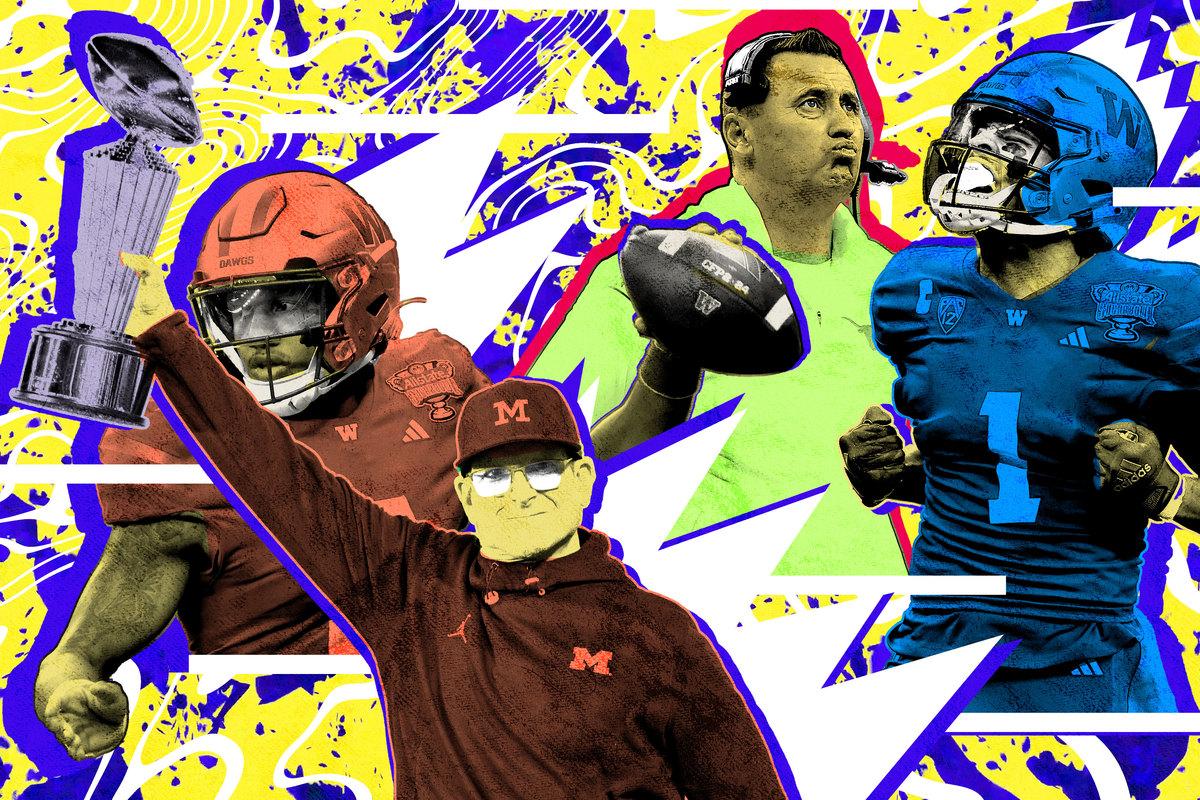Seven Takeaways From the College Football Playoff Semifinals
Michigan beat Alabama in an overtime thriller in the Rose Bowl. Washington held off Texas despite a ridiculous end sequence in the Sugar Bowl. The final semifinals of the four-team playoff era were ridiculously good—and taught us plenty about what the title game could have in store.
What a phenomenal day of college football. Undefeated Michigan—the program at the center of the saga that defined the 2023 season—won its first-ever playoff game in a 27-20 overtime thriller against Alabama in the Rose Bowl. The nightcap was just as thrilling: Washington held off Texas 37-31 in the Sugar Bowl after the Longhorns’ pass to the end zone as the final second ticked off the clock fell incomplete. You couldn’t have asked for two better games. Michigan and Washington will play for the national championship on January 8.
Before we get into that matchup, though, let’s break down what we just saw. Here are seven takeaways from the final two semifinals of the four-team College Football Playoff era.
Washington Barely Survived an (Almost) All-Time Collapse
Washington led 34-21 with less than 13 minutes remaining in the fourth quarter when it scooped up a fumble by Longhorns running back Jaydon Blue on its own 24-yard line. The Huskies then proceeded to call five straight passes—all five fell incomplete, with one being negated by an offensive penalty—and punted 88 seconds later. That was the start of what nearly became one of the worst and most devastating collapses in college football history.
Adonai Mitchell made a leaping touchdown catch on Texas’s next possession to cut the score to 34-28. Then Washington and Texas traded field goals. The Longhorns attempted an onside kick trailing 37-31 with two timeouts and 1:09 left in regulation, and Washington made what should have been a game-clinching recovery. If Washington would’ve kneeled the ball three times and punted, Texas, at best, would have gotten the ball back with about 10 seconds left and zero timeouts. But misfortune struck for Washington.
Huskies running back Dillon Johnson was injured on the third-down handoff, stopping the clock with 50 seconds remaining. Texas, improbably, had a chance. Washington then committed fair catch interference on the ensuing punt, moving Texas up 15 yards to their own 31 to begin the final drive. Two absurd sideline catches later, and the Longhorns made it all the way to the Washington 12-yard line with 15 seconds to go. Washington played a nearly perfect game for the first 50 minutes of the Sugar Bowl. But a series of clock management mistakes and a little bad luck came close to rendering it all for naught.
Which brings us to the next takeaway …
Steve Sarkisian Blew an (Almost) All-Time Comeback
Texas head coach Steve Sarkisian is one of college football’s top offensive minds and a major driver behind Texas’s offensive success this season. He also completely blew it with the final four offensive calls against Washington.
Down by six points with 15 seconds on the clock, Texas had a first down at the Washington 12-yard line. Sark inexplicably called a swing pass to the running back to open things up; Washington was on it immediately, and the Longhorns lost a yard. The next play was supposed to be a vertical shot to Mitchell, but Washington blanketed Texas’s pass catchers; quarterback Quinn Ewers just sailed the ball out of the back of the end zone. Next, Washington freed up an unblocked defender on a blitz, forcing Ewers into another quick throwaway. One more missed vertical to a well-covered Mitchell in the end zone, and that was the ball game.
Washington’s defense held, but Sarkisian simply had to be better and more creative in that situation. Also, working from the 12-yard line, Texas could have stopped the clock with a first down before throwing prayers into the end zone. Maybe that wouldn’t have worked either, but it certainly would have been better than what they did. Texas had four shots to get 12 yards, with a berth in the national championship game on the line. The offense ended up moving backward.
Jim Harbaugh Is One Win Away From College Football Immortality
Love him. Hate him. Suspend him. It doesn’t seem to matter. Jim Harbaugh keeps on winning.
Harbaugh and Michigan have won three consecutive Big Ten championships, and finally, he has won his first College Football Playoff game. Harbaugh not only managed to keep the Wolverines focused throughout this season’s ongoing sign-stealing scandal, but he also turned all the negative attention and criticism into a source of motivation. They’re not cheaters; they’re America’s team. It’s “Michigan vs. Everybody.” The optics of transforming this story into a victimization narrative notwithstanding: It’s clearly working! And Harbaugh just secured his first spot in a national title game by outcoaching Nick Saban.
While Alabama clung to the lead late in the fourth quarter, the better team won in the Rose Bowl. Michigan was the better prepared team. Both its coordinators, Sherrone Moore and Jesse Minter, called masterful games. The Wolverines outgained Bama 351 yards to 288, and they pushed all the right buttons in crucial situations: Harbaugh made the decision to go for it on two key fourth downs; not only did the Wolverines convert both, but each of those drives ended in touchdowns. It was a master class from Harbaugh and his staff.
Sherrone Moore and Jesse Minter Are NFL-Caliber Coaches. Tommy Rees Is Not.
Michigan doesn’t win the Big Ten, let alone make it to the national championship, without the contributions of offensive coordinator Sherrone Moore. He went 4-0 as an interim head coach through Harbaugh’s two 2023 suspensions, including a 30-24 win over Ohio State. And his impact as a play caller was remarkable in the program’s first playoff win.
Moore simply outclassed his Crimson Tide counterpart, Tommy Rees. The disparity between the two offensive play callers in this game couldn’t have been more significant. Rees didn’t come up with an adjustment to move the pocket for quarterback Jalen Milroe until after Michigan had sacked him five times in the first half. Rees made adjustments over the course of the game, but his situational play-calling was disastrous, particularly on the final decisive play in overtime.
Facing a fourth-and-3 and trailing by seven in overtime, Rees called quarterback power, a run for Milroe right into the teeth of the Michigan defense. Motioning into an empty formation from 11 personnel and running at the interior of the Michigan defensive line put Alabama’s offense at a clear disadvantage. With or without the low snap (something that was a problem throughout the game), Milroe never stood a chance. The Wolverines immediately penetrated the backfield and tackled Milroe 2 yards short of the goal line; Alabama’s season was over.
Michigan defensive coordinator Jesse Minter also deserves praise for his performance. He had Rees and Milroe in hell all game with a series of disguised blitzes, games, and stunts. Minter’s aggressive and complex defensive game plan prevented Alabama from ever getting comfortable with its dropback passing game. Part of that is Milroe’s limited skill set as a passer, but most of the credit should go to Minter and Michigan’s front seven. By the second half Rees had pivoted completely to the quick game, utilizing a diet of play-action, moving pockets, and RPOs. That’s hard to survive on if anything negative happens on early downs. Alabama faced third downs of 9 or more yards seven times; it converted zero of them.
Both Moore and Minter showed they have NFL chops on Monday. Maybe both will follow Harbaugh to the NFL if (when???) he returns to the league.
Alabama’s Offense Needs a Reset Moving Forward
We’ve established that Rees doesn’t have it. Milroe can be limited as a passer. Center Seth McLaughlin’s performance snapping the football on Monday—he was either too low or too high all game—caused issues. But one of the Tide’s biggest problems was their receiving corps.
Isaiah Bond, a true sophomore who was a four-star recruit, led Alabama in receiving against Michigan with four receptions for 47 yards. Jermaine Burton, the team’s leading receiver for the season, finished with just four catches for 21 yards. Neither player had more than 800 receiving yards on the year, marking the second straight season that the program has gone without an 800-yard receiver. It used to be a foregone conclusion that Alabama would trot out NFL talent at receiver every single year, from Julio Jones to Amari Cooper to Calvin Ridley to DeVonta Smith to Jaylen Waddle. That’s simply no longer the case.
Alabama went three straight drafts, from 2020 to 2022, with at least two wide receivers picked inside the first 50 selections. None were drafted in 2023, and Burton will be a day-two pick (at best) in 2024. Burton is also a transfer from Georgia. Wide receiver Jameson Williams and running back Jahmyr Gibbs, the last two skill players drafted in the first round out of Alabama, were transfers. The Tide’s return to offensive dominance will start with identifying and developing skill-player talent at both the high school level and in the transfer portal.
Michael Penix Jr. Is Soaring Up NFL Draft Boards
Washington quarterback Michael Penix Jr. played the best game of his career at the best possible time. He was otherworldly with his ball placement on downfield throws against Texas. The 29-yard flick to Germie Bernard under duress? The seed to Ja’Lynn Polk on the post-corner route for 77 yards? The bucket drop to Rome Odunze early in the second quarter? The frozen rope to Jalen McMillan for the score at the start of the second half? Every throw was more impressive than the last, as Penix showed off his unique arm talent and accuracy. He finished 29-of-38 passing for 430 yards with two touchdowns and zero interceptions.
Penix also rushed three times for a season-high 31 yards. He navigated pressure well and looked spry and athletic while doing it. Penix is 23 and has an extensive injury history, but he looked as healthy as he’s ever been in the win over the Longhorns. Caleb Williams and Drake Maye will likely top the 2024 draft class, but Penix’s performance surely has plenty of NFL teams thinking about whether he fits into their future.
Washington’s Receiving Corps Is Ridiculously Good
Don’t let any of the (deserved) Penix hype take away from the fact that Washington has three legit NFL prospects at wide receiver.
Rome Odunze, who led Washington with 125 receiving yards on six catches Monday, is the best of the bunch. The 6-foot-3 215-pounder is a smooth athlete with unreal ball skills. Penix can put the ball wherever he wants, but Odunze often makes his ball placement look that much better because of his ability to adjust to throws in the air. Odunze is über-fast, has reliable hands, and constantly and effortlessly creates separation thanks to his deep bag of releases off the line of scrimmage and impressive footwork at the beginning of his routes.
Ja’Lynn Polk won’t get the same level of draft hype as Odunze, but he showed a national audience Monday that he’s a damn good receiver in his own right. While Odunze is a potential top-10 selection in April’s draft, the 6-foot-2, 204-pound Polk is a fringe first-rounder. Yet it was hard to see a difference between the two players on Polk’s 77-yard reception in the first half. His speed and route-running ability were on full display on this post-corner route:
Finally, while Jalen McMillan isn’t in the same tier as Odunze and Polk, he should be a top-100 player in April’s draft. Listed at 6-foot-1 and 192 pounds, McMillan had five catches for 58 yards with a score against Texas. While he had the lowest average depth of target among Washington’s top receivers in 2023, his YAC per reception average of 7.5, per Pro Football Focus, was by far the best. He’s a shifty athlete who can make people miss in space.
One of the most exciting offenses in college football is now about to take on the nation’s top-ranked scoring defense, with a ton of juicy story lines to boot. Next Monday will not only bring the conclusion to the four-team playoff era—it will bring a matchup worthy of the stage.

